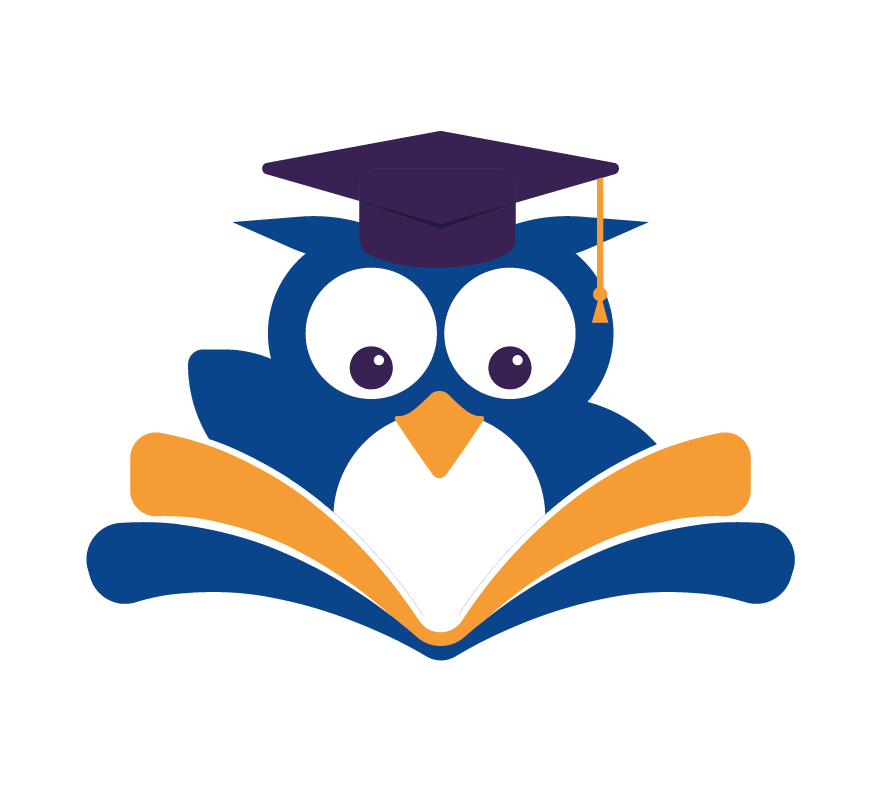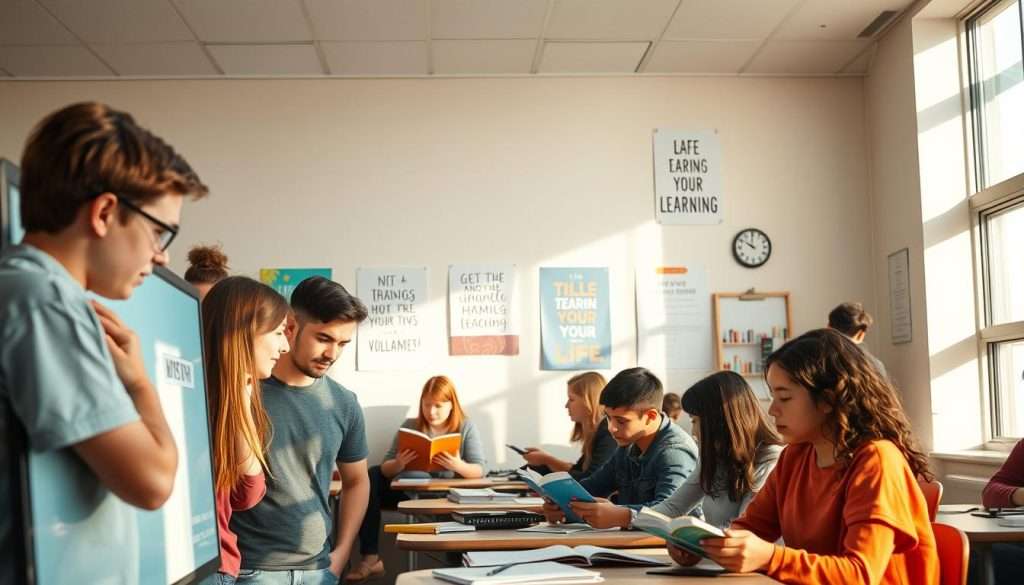Ever wondered why some study methods work great for you, while others don’t? It’s not just about studying a lot. It’s about knowing how your brain handles new info.
We’re here to share efficient learning techniques that can transform your study time. By exploring the science of brain function, we can accelerate learning and make it more effective.
Imagine learning and remembering like a sponge, making studying fun and productive! With the right strategies, you can create better study habits that stick with you forever.
Key Takeaways
- Discover the science behind effective learning and how to apply it.
- Learn how to accelerate your learning process.
- Develop better study habits that are sustainable.
- Understand the role of neuroplasticity in learning.
- Apply practical tips to enhance your learning experience.
The Science Behind Effective Learning
Learning how our brains handle information is crucial for better learning. When we learn something new, it goes through a complex system in our brains.
How Your Brain Processes New Information
Let’s explore the amazing world of neuroscience. It shows how our brains work together.
The Role of Neurons and Neural Pathways
Neurons are the basic parts of our brain’s learning system. They talk to each other through neural pathways. These pathways get stronger as we learn more.
Working Memory vs. Long-Term Memory
It’s important to know the difference between working memory and long-term memory. Working memory is like a mental sticky note for temporary info. Long-term memory is like a big storage room for info we keep for a long time.
| Memory Type | Capacity | Duration |
|---|---|---|
| Working Memory | Limited (7 ± 2 chunks) | Short-term (seconds to minutes) |
| Long-Term Memory | Large (virtually unlimited) | Long-term (hours to years) |
Knowing these concepts helps you use advanced learning strategies. This way, you can improve your learning skills and learn faster. It helps you use both working and long-term memory better.
Assessing Your Current Learning Habits
Understanding your learning habits can change your educational path. First, figure out how you learn best.
Identifying Your Learning Style
Everyone learns differently. Do you learn better with pictures, sounds, reading, or by doing things? Knowing this helps you study smarter.
Visual, Auditory, Reading/Writing, and Kinesthetic Preferences
Visual learners get a lot from pictures and diagrams. Those who learn through sound do well with talks and discussions. Reading and writing learners like books and notes. Kinesthetic learners learn by doing things with their hands.
| Learning Style | Preferred Learning Methods |
|---|---|
| Visual | Diagrams, charts, images |
| Auditory | Lectures, discussions, audio materials |
| Reading/Writing | Textbooks, notes, writing summaries |
| Kinesthetic | Hands-on activities, experiments, practical exercises |
Recognizing Ineffective Study Patterns
It’s important to spot habits that slow you down. Do you cram for tests or put off studying? Spotting these habits is the first step to changing them.
Setting Clear Learning Objectives
Having clear goals makes learning better. SMART goals help you stay on track.
SMART Goals for Learning
SMART means Specific, Measurable, Achievable, Relevant, and Time-bound. SMART goals give you a clear plan for learning.
Creating the Optimal Learning Environment
To improve your learning, make your surroundings better for focus and less distracting. Your study area greatly affects how well you learn and remember new things.
Physical Space Optimization
Begin by cleaning up your study area and sorting out your stuff. A neat space helps you focus better. Think about the lighting, temperature, and comfort too.
Minimizing Distractions
Find out what distracts you, like social media or loud places. Then, find ways to avoid them. This could mean using website blockers or finding a quiet place to study.
Digital Detox Strategies
Try a digital detox by turning off notifications while you study. You can also use apps to help you stay on track.
Tools and Resources for Enhanced Focus
Try tools like the Pomodoro timer, noise-cancelling headphones, or apps that boost productivity. See what works best for you by trying different things.
The Power of Active Learning Strategies
Active learning changes the game when it comes to learning new things. By getting involved with what you’re studying, you can learn faster and better. This makes learning more effective.
From Passive to Active Learning
Switching from passive to active learning is key. Instead of just reading or listening, start to really engage with the material. Ask yourself questions like “What’s the main idea?” or “How can I use this?”
Effective Note-Taking Techniques
Good note-taking is a great way to get into your study material. Two top methods are the Cornell Method and Mind Mapping.
Cornell Method
The Cornell Method splits your paper into two parts. The smaller side is for keywords and questions, and the bigger side is for notes. It makes reviewing and remembering easier.
Mind Mapping
Mind Mapping is a visual way to organize your notes. You start with a central idea and add related ideas around it. It makes information easier to see and organize.
| Note-Taking Method | Description | Benefits |
|---|---|---|
| Cornell Method | Divides paper into two columns for keywords and notes | Efficient review and recall |
| Mind Mapping | Visual map of notes starting from a central idea | Organizes and visualizes information |
Teaching Others to Solidify Knowledge
Teaching what you’ve learned to others is a powerful strategy. It not only makes you understand better but also helps you remember it longer.
The Feynman Technique
The Feynman Technique is about explaining a concept in simple terms. Imagine you’re teaching it to someone else. It helps you find out what you don’t know and makes your understanding stronger.
By using these active learning strategies, you can learn more, faster, and retain it better. It turns learning into an exciting and interactive experience.
Memory Enhancement Techniques
Memory is key to learning, and the right strategies can boost your recall. We’ll look at some top memory boosters to help you learn better.
Spaced Repetition Systems
Spaced repetition is a top memory booster. It reviews material at longer intervals to lock it in your long-term memory.
Using Apps Like Anki and Quizlet
Apps like Anki and Quizlet make spaced repetition easy. They let you create digital flashcards and schedule reviews automatically.
Mnemonic Devices and Memory Palaces
Mnemonic devices are great for memory. They link new info to something you already know or find memorable.
Creating Vivid Mental Associations
To use mnemonic devices well, make mental connections vivid. Use acronyms, rhymes, or mind maps to remember better.
Chunking Information for Better Retention
Chunking breaks down big info into smaller bits. It makes info easier to organize, remember, and recall.
Dual Coding: Combining Words and Visuals
Dual coding mixes words and images to boost memory. It creates a strong memory trace by using both.
| Technique | Description | Benefits |
|---|---|---|
| Spaced Repetition | Review material at increasingly longer intervals | Improves long-term retention |
| Mnemonic Devices | Associate new information with something memorable | Enhances recall and memory |
| Chunking | Break down information into smaller chunks | Improves organization and retention |
| Dual Coding | Combine verbal and visual information | Creates a more robust memory trace |
Time Management for Accelerated Learning
Effective time management is key for quick learning. It lets you use your study time wisely. By using the right strategies, you can improve your learning skills and learn faster.
The Pomodoro Technique for Focused Study
The Pomodoro Technique means studying in 25-minute blocks, then taking a 5-minute break. It keeps you focused and stops burnout. This makes your study time more productive.
Batching Similar Learning Tasks
Grouping similar tasks together boosts your productivity. For example, set aside certain days for different subjects or study activities. This keeps you in a flow state and makes learning more effective.
Creating a Sustainable Learning Schedule
A good schedule is vital for steady learning. When planning your schedule, think about your goals and how much time you have.
Balancing Intensity and Recovery
It’s important to mix intense study with rest. Enough rest and relaxation prevent burnout and keep you motivated. Finding the right balance helps you keep better study habits and reach your learning goals.

Using these time management tips can speed up your learning and make your study time count. The aim is to learn more efficiently, not just to study more.
How to Learn More, Learn Faster, Learn Better with Technology
Technology has changed how we learn, offering many tools to improve our studies. Now, we can accelerate learning and do it more efficiently.
Digital Tools for Enhanced Learning
Digital tools are key to better learning. They let us access lots of information easily.
Note-Taking and Organization Apps
Apps like Evernote, OneNote, and Simplenote help us stay organized. They let us improve learning skills by organizing and reviewing notes well.
| App | Features | Platform |
|---|---|---|
| Evernote | Note-taking, organization, tagging | Web, iOS, Android |
| OneNote | Note-taking, organization, collaboration | Web, iOS, Android |
| Simplenote | Note-taking, minimalistic interface | Web, iOS, Android |
AI-Powered Learning Assistants
AI-powered learning assistants are getting popular. They offer personalized learning experiences. These tools use advanced learning strategies to help us learn better.
For example, they can spot knowledge gaps and suggest ways to improve.
Online Courses and Learning Platforms
Online courses and platforms make learning easy. Sites like Coursera, Udemy, and edX have many courses on different subjects.
Choosing the Right Resources for Your Goals
When picking online courses or platforms, think about your goals. Choose resources that match your objectives. This way, you can enhance your learning process and reach your goals.
By using these digital tools and resources, we can improve our learning skills. Learning becomes more fun and effective.
Overcoming Learning Plateaus and Obstacles
Learning something new can sometimes feel like hitting a wall. But, there are ways to break through. We’ve all felt stuck or overwhelmed at some point. With the right strategies, you can keep moving forward.
Dealing with Information Overload
In today’s world, it’s easy to get lost in too much information. To avoid feeling overwhelmed, learn to filter what’s important. Prioritize information and use tools like bookmarking apps to organize your resources.
Here’s a simple way to manage information overload:
- Identify your learning goals
- Focus on one resource at a time
- Take notes and summarize key points
Strategies for Difficult Subjects
Some subjects are harder than others. When faced with a tough topic, break it down into smaller parts.
Breaking Down Complex Topics
Complex topics can seem overwhelming. But, by dividing them into smaller parts, they become easier to handle. For example, start with the basics of a new programming language before moving on to more advanced concepts.
| Step | Action |
|---|---|
| 1 | Identify the core components of the topic |
| 2 | Create a learning plan |
| 3 | Focus on one component at a time |
Maintaining Motivation During Challenges
Staying motivated is key when facing learning obstacles. One way to stay motivated is by building a support system. This could be a study group, a mentor, or online communities.
Building a Support System
Having people who understand your challenges can make a big difference. Share your goals and progress with them. Don’t hesitate to ask for help when you need it.
“Surround yourself with people who are better than you, and empower them to do their best work.”
Managing Learning Anxiety and Imposter Syndrome
Learning anxiety and imposter syndrome are common. To manage these feelings, focus on your progress. Remember, it’s okay to not know everything.

By using these strategies, you can improve your learning skills and stay motivated. Remember, the key is to keep going, even when it’s hard.
Applying Knowledge: From Theory to Practice
The true test of learning is applying what you know to real-world problems. To improve learning skills, you need to connect theory with practice.
Project-Based Learning Approaches
Project-based learning approaches are a great way to do this. They involve working on real projects that use what you’ve learned. This method enhances the learning process by making it more fun and relevant.
- Identify a problem or challenge that interests you
- Research and gather relevant information
- Develop a plan to address the problem
- Implement your plan and iterate based on feedback
Reflect on your experience and identify areas for improvement
Creating Real-World Applications
To accelerate learning, create real-world applications of your skills. This approach helps you develop advanced learning strategies and boosts your confidence.
The 20/80 rule says 20% of your effort can lead to 80% of the results. Focus on the most important parts of your project to make the biggest impact.
Building a Portfolio of Learning Projects
As you work on projects, build a portfolio to show off your skills. This will help you accelerate learning by showing your abilities and where you can improve.
Deliberate Practice Techniques
To get better and master your skills, use deliberate practice techniques. Focus on specific areas, set tough goals, and get feedback from experts.
Tracking and Measuring Your Learning Progress
Measuring your learning progress is like checking your GPS – it helps you stay on course. To improve learning skills and develop better study habits, you need to regularly assess how far you’ve come and adjust your strategy.
Effective Self-Assessment Methods
One powerful technique for self-assessment is knowledge mapping. This involves creating a visual map of your knowledge, connecting new information to what you already know.
Knowledge Mapping
By using knowledge mapping, you can enhance your learning process and identify areas that need more attention. It’s a great way to accelerate learning by focusing on the most important topics.
Using Data to Refine Your Learning Process
As you track your progress, you’ll gather data on what’s working and what’s not. Use this information to refine your efficient learning techniques and make adjustments to your study plan.
Celebrating Milestones and Achievements
Don’t forget to celebrate your successes along the way! Recognizing your achievements helps to motivate you to continue improving your learning skills.
The Importance of Reflection
Reflection is a crucial part of the learning process. Take time to reflect on what you’ve learned, what worked well, and what didn’t. This will help you enhance your learning process and develop better study habits for future learning.
Conclusion: Your Journey to Becoming a Super Learner
We’ve covered many ways to learn more effectively. You now know how your brain handles new info, a key step to faster learning. We talked about setting up the best learning space, using active learning, and how tech can accelerate learning.
To become a super learner, adopting better study habits and efficient learning techniques is crucial. This way, you’ll learn and remember better, reaching your goals and dreams.
Now, it’s your turn to keep using these strategies every day. Stay dedicated, be patient, and celebrate your successes. Learning is a lifelong adventure, and with the right attitude, you can achieve amazing things.

